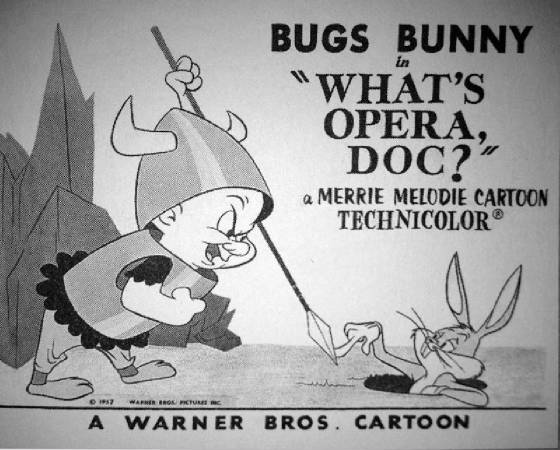|

(1957, directed by Charles M. Jones)
- inducted 2018 –
“Warner Bros. animation director Charles M. ‘Chuck’ Jones was known for his love of the snootier aspects
of culture, specifically opera and ballet. He also craved far more lowbrow material like comic wordplay, violent slapstick
and parody, characteristics for which the Termite Terrace brand of shorts were notorious. Jones’ 1957 Merrie Melodies
feature What’s Opera, Doc? is the quintessential synthesis of these seemingly disparate elements, a take on Richard
Wagner that is simultaneously a parody and a working example of what it mocks. Under all the jokes, there’s an earnest
respect for opera and dance; Jones and his animators were serious enough to ensure the physical accuracy of the ballet moves
of his characters, despite the fact that they are a rabbit in Bavarian drag and a lovestruck bald man armed with a spear and
magic helmet.
“That spear and magic helmet allows screenwriter Michael Maltese to provide unforgettable lyrics for Wagner’s
Ride of the Valkyries. ‘Kill the wabbit! Kill the wabbit! Kill the wabbit!’ yells Elmer Fudd as he jabs
his spear into the home of his antagonist since 1940, Bugs Bunny. Maltese scripts Elmer’s usual first line, ‘be
vewy quiet, I’m hunting wabbits,’ but this time Elmer sings it in fealty to the operatic rules. Bugs sings too,
working in his trademark ‘What’s Up, Doc?’ over Wagner’s horn melody. The expected chase ensues, with
Bugs toying with Elmer’s emotions and occasional obliviousness while casually outsmarting him at every turn.
“Or so we think. What’s Opera, Doc? is Jones plopping a standard issue Bugs and Elmer cartoon into a more
ominous structure, making it the greatest cartoon Warner Bros. ever produced. As his Road Runner cartoons prove, Jones loves
to exercise creative discipline, and he’s a stickler for the obstructions he gives himself. So, spoofing Wagner means
incorporating the tragedy and magic integral to his plots. This makes Elmer an actual threat rather than simply a comic foil;
his ‘sample’ of spear and magic helmet power is far more accurate in its destruction than his usual shotgun marksmanship.
‘Bye!’ Bugs says to us just after the tree he’s standing under gets obliterated by Elmer’s ‘Flying
Dutchman’-scored lightning bolts.
“Despite facing a stronger foe, Bugs employs his usual means of ‘stragedy’ (as he’d call it). The
midsection of What’s Opera, Doc? finds him once again engaging his vaudevillian penchant for dressing as a woman
to lure the lovesick and horny Elmer Fudd off his single-minded quest of huntin’ wabbits. Here, Bugs is Brunhilde, appearing
on a giant white horse against some of the weirdest backgrounds Maurice Noble ever drew. Elmer is beyond smitten—Jones’
famous facial expression drawings speak volumes of emotion—and he and Brunhilde dance and sing in courtship.
Their song, by Maltese and Wagner, is a showcase for Arthur Q. Bryan (as Elmer) and Mel Blanc (as Bugs). It’s here that
one realizes just how good these guys are at working together, their voices playing off each other and melding in a harmony
that is delivered sincerely for maximum emotional effect. For a moment, the duo sells this love story built on self-preserving
subterfuge.
“Of course, Bugs’ ruse is eventually discovered, which leads a raging Elmer to finally get what he’s been
desiring all these years—he kills the wabbit! An opera demands a tragic ending, and Elmer’s first (and only) successful
hunt of Bugs sends him into spasms of remorse and guilt. What’s Opera, Doc? milks Bugs’ demise for all
the melodrama an opera death is worth, sprawling him under a broken flower that rains ‘tears’ upon his lifeless
body. Elmer’s final, hauntingly delivered lyrics prove that this performance is Arthur Q. Bryan’s masterpiece.
Jones lets Bryan have his sadness while, unbeknownst to Elmer, Bugs reassures the viewer that he’s really OK. ‘What
did you expect from an opera?’ he asks. ‘A happy ending?’ Of course not.”
~ Odie Henderson
|

